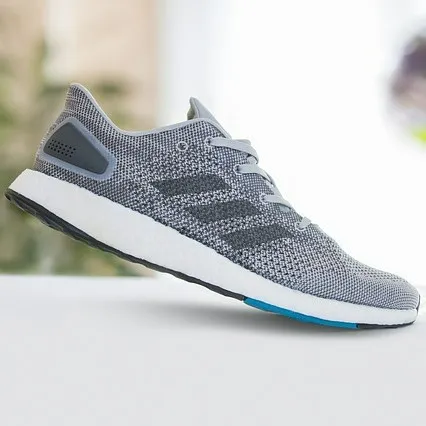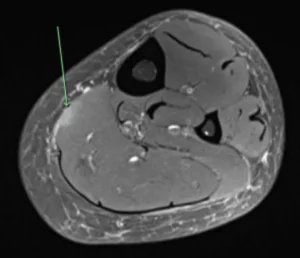In This Article
Returning to running after calf injuries is one of the most risky times for a runner. With the right guidance, you can reduce your chance of tweaking the calf again and delaying your recovery.
The tricky aspect of calf injuries is how they function to propel us forwards (or upwards).
The calf muscle can tick away during comfortable running, barely operating at 30-40% of its capacity.
But when you increase your pace a little, the calf responds by increasing its power a lot with more force and faster speed of contraction.
That disproportionate increase in calf output can make it difficult to plan a smooth return to running.
One seemingly simple step up in your training can suddenly overload the recovering calf muscle and cause a return of your symptoms.
In this post, we’ll explain how different types of running after calf injury will put different loads on the muscle, and how you can design your running program to minimise the risk of re-injuring the calf muscle.

Need a running shoe to help ease calf pain?
Our Physio experts have listed the key shoe features to look for if you’ve got calf pain, including recommended brands and models.
Different types of calf injury
The calf muscle is actually made up of two different muscles, and one of those muscles has two distinct parts.
There’s the deeper Soleus muscle, a large triangular-shaped muscle that’s responsible for bracing the ankle on landing and providing much of the rigidity that the Achilles tendon needs to store force.
Then there’s the more famous Gastrocnemius muscle, the bulkier muscle at the top of the calf that provides the spring and power for explosive movements such as sprinting and jumping.
Each muscles performs a very different function, which needs to be considered when designing your return to running plan.
There’s also a range of injuries that can occur to these muscles – from a strain (overload without structural damage – see the image below) to a muscle tear.

Muscle tears take longer to heal than muscle strains, so a return to full capacity from a muscle strain may be 2-4 weeks while a muscle tear might take 6-12 weeks.
We’ll make reference to these pathologies in the design of our training program below.
If you don’t know your specific diagnosis, I strongly recommend that you make a quick visit to your Doctor or Physiotherapist and get a firm diagnosis as it dictates how you’ll adjust your running plan going forward.
Effect of calf injury on running technique
The calf muscle complex is one of the key drivers of running, particularly faster or uphill running.
After a calf injury, the brain adjusts how it generates its propulsion and tries to use other aspects of the running action to push you along.
For example, it adjusts the landing position of your foot slightly further forwards. This allows it to “pull” with the hamstrings when the leg is in front of you, rather than “push” with the calf when the leg is behind you.
Unfortunately every adjustment has consequences – more demand on the hamstrings is also associated with more hip movement, nerve stretch and impact loading on bones.
As you fatigue, these adjustments become less effective (as the compensating muscles begins to get tired) and other compensations must begin to kick in.
That can work for a period of time until the body (and brain) run out of alternatives and the calf is called on, often leading to re-injury.
The other consideration is that the brain will often call on the uninjured side to do more (assuming that only one calf is injured), but that overloads the other side. This can lead to injuries on the good side or, as it fatigues, a sudden shift in load back to the injured side.

Program changes for running after calf injury
Here are the aspects of a typical running program and how they relate to running after calf injury:
Frequency of sessions
For returning to running after calf injuries, running 3-4 times per week is your ideal frequency.
The calf muscle works a lot harder if other muscles are fatigued, so taking a recovery day between sessions is important in your rebuilding phase.
The recovery day between running sessions can still be used for cross training or strength work, so it’s not a wasted day.
Speed sessions
Unfortunately there’s no way of hitting top speed without utilising the calf muscle in a big way.
So your best compromise is to lengthen your speed intervals. If you can’t hit top speed, make your 200m intervals into 800m intervals so they don’t rely on a fast pace to make them worthwhile.
The other consideration here is that the greatest calf forces are experienced during acceleration. Comparing the two, 4 x 800m would only have 4 acceleration phases compared to 8 x 400m which would have 8.
Long runs
Long runs are slower so they don’t need as much calf muscle power (as you push off), but there is more fatigue due to the duration.
So the safest way to cover your long run is to keep it fairly flat (ie. avoid hills) and add short walk breaks at set intervals.
And while this may not sound like the sexiest option (runners having to walk, WTF!!!), it’s better than only covering half the distance or flaring the injury up again. It’s also a viable option to complete longer races before you’re back to 100% (popularised by Olympian Jeff Galloway).
Vertical/hill sessions
Running uphills or stairs is a problem as the running action required is very calf-dominant and mimics a sprinting action.
These sessions are one of the last sessions to be reintroduced in the final weeks of your rehab program.
Sample running program (with explanations)
This program would be an early (building) phase program that I’d use for one of my mid-pack 10k runners. The program assumes that you’re already running 10-15min at an easy/comfortable pace.
It would vary each week but this gives an overview of the rationale behind the design.
| Day | Session | Reason |
| Monday | Cross training session | Swimming, cycling (remaining seated), ski erg and rower are useful for cross training |
| Tuesday | Fartlek session 20min | 2min on, 2min off, shifting from a comfortable pace to only slightly faster for the “on” phases |
| Wednesday | Swimming | Swimming is one of the most effective recovery sessions |
| Thursday | Incremental tempo 20min | For this session, start at a very easy pace and step the pace up every 5min/1km (total distance ~ 4km) |
| Friday | Rest day | |
| Saturday | Easy run 15min | This session is to improve running technique efficiency without adding fatigue before Sunday’s long run |
| Sunday | Long run:walk 60 minutes | The run:walk design (4 minute run : 2 minute walk) allows for fatigue to build endurance but reduces its negative effect on running technique |
